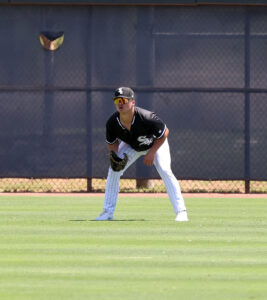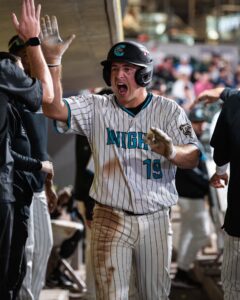Exclusive Interview: Birmingham Barons Pitching Coach J.R. Perdew

In recent history, the White Sox organization has set itself apart as one of the best producers of pitchers in the industry. Certainly the major league club’s pitching coach and former minor league pitching coordinator Don Cooper has been given plenty of praise for his work on the South Side, but past Cooper, there are a lot more people working behind the scenes to aid the White Sox in their arms factory. Talking with people on the White Sox development team, they’ll routinely give praise to a few different guys and J.R. Perdew, the Barons pitching coach, is one of the names often brought up.
Perdew, a former college baseball player and U.S. Marine, has been a pitching coach in the White Sox organization for 19 years now. Perdew has worked in Rookie Ball, Low-A, High-A and Double-A. Incredibly enough, Perdew has worked multiple seperate stints in Kannapolis, Winston-Salem and now Birmingham.
J.R. was kind enough to take some time out of his day to talk with us about White Sox top pitching prospect Carson Fulmer, some of his pitching philosophy and some other young pitchers in the White Sox organization.
Brian Bilek: So starting with Fulmer, you worked with him last year in Winston-Salem, and now this year, the two of you head up to Birmingham together. Obviously things haven’t been gone as well as Carson would have hoped so far or as well as they did when you were in Winston-Salem. What is the one major difference in his performance that fans can’t really see in the box score?
J.R. Perdew: I think he’s the same guy really. He’s came in here with a lot of talent and obviously we’re not here to take that away from him. We want him to be himself and with the talent he brought from Vanderbilt – that ‘s what we want here too. We’re not going to change anything. And with any pitcher, I don’t care if it’s high school or the big leagues, sometimes they get a little bit out of wack and go through periods where they’re just not as good but he’ll get it turned around. There are always concerns with any pitcher when they have a rough outing or a few rough outings in a row but Carson’s proven that he could pitch at this level. He had four good games in a row but I don’t really get into the overall stats because they can be deceiving. It’s easy to look in the walk column and say, ‘yeah, he’s got a lot of walks’ but he also had four games with twenty-three innings with only five walks and then eighteen innings with three walks.
He struggled in his and his second starts and then obviously the other day against Jackson he had a really rough day. I just look at those as growing pains. He’s learning new things and he’s improved in a lot of ways. He’s really upgraded his change up from last year. He’s learned how to pitch inside with his two-seamer a lot better. Those are both big positives but right now we got to get better at keeping the ball in the strike zone.
Brian: At the end there, you hit on what I was going to ask you next with the change-up. Just having the improvement and being able to drop it in against lefties, would you say that is his biggest improvement this year?
J.R: Yeah, and to be honest, he’s used it really well against righties. The O’Neill kid (Mariners’ prospect Tyler O’Neill) from Jackson is a real good hitter in this league and Carson made him look bad with two change-ups in one sequence and struck him out. There’s no doubt his change-up has come a long way. Like I said, right now he’s going through a tough time and I told him the other day, “There’s some guys sitting in the Hall of Fame right now and somewhere in their minor league career they’ve had some rough moments.” I mean I’ve talked Bob Feller, and Bruce Sutter, Greg Maddux, guys like that. They all went through it. Maddux definitely had some struggles. Carson’s a great kid, he works hard and that’s the biggest thing: keeping his positive outlook and keep working hard.
Brian: For Fulmer, just being drafted by the Sox and following Chris Sale and Carlos Rodon, it had to be difficult. When I spoke to Rick Hahn about Fulmer he said that the Sox were spoiled with the way those two pitchers flew the ranks but it brings some expectations for Fulmer that aren’t normal for a guy just leaving college ball but when he was leaving Vanderbilt, one of the few knocks on him was that he could stay out of the zone and be successful because the competition wasn’t challenging him enough. Do you think he could be going through a correction process with that in mind?
J.R.: Yes. Absolutely, I think you hit the nail on the head. For me, in professional baseball, especially at the higher levels, you have to learn to get the guys out in the zone. These guys aren’t going to get themselves out outside of the zone until you prove you can be in it. So yeah, I do think that’s a correction thing, absolutely.
I’ve had a lot of guys in the past that would dominate at High-A and they would get to Double-A and struggle at first because of that adjustment period. They were always trying to get guys out outside of the zone because a lot of the younger hitters will chase out of the zone. But yeah, that’s another adjustment he’s going to have to make and he’s good enough to make it. I am not worried about it.
Brian: Taking a guy like Fulmer who is going through what I assume is his first struggles in baseball, there’s certainly some mental coaching that you have to do there. How much of your job do you think is psychological?
J.R.: I do believe a lot of it is. Every player is different. Some guys need an arm put around them, some guys need some confidence and some guys need a hard talking to sometimes. Whatever it is. You just gotta learn the player.
With Carson, I gotta say, he’s a high-character kid. I have two daughters and for me, the respect that I have for Carson Fulmer as a man, if my daughter marries a man like Carson Fulmer one day, and I mean that from the bottom of my heart, I am going to be a happy man. He’s just that great of a person.
I believe with his character and the person he is, he’ll get through anything that comes his way. I really believe that. He’s a positive kid and he’s a great teammate. Even the other night, I have to give the kid a lot of credit. He had a rough outing. After he went in the clubhouse and gathered his thoughts, he came back in the dugout and he was a teammate the rest of the game. He cheered for his teammates the whole rest of the game.
There’s something special about him. A lot of kids that don’t have that character would hit a tough bump in their career and not handle it as well, but he’s a high character kid and he’s going to be fine.
Brian: There’s been a joke with White Sox fans that Cooper will teach any given pitcher a cutter. But talking to some of the younger pitchers in the organization, you’re kind of known as the cutter guy in the minors. Why would you say the White Sox use that pitch more than the rest of the industry?
J.R.: I think it goes by the style. Basically, Coop is the one who decides which guys need cutters or even Curt Hasler. Most of the time it’s just the style of pitcher we have. I don’t know if we use it more, it’s just becoming the new pitch. I think we’re seeing a lot of guys fall in love with it too. It’s kind of like when the splitter came in the 80’s. Everybody seemed to have a split except me because I didn’t have big enough fingers.
As far as me teaching the cutter, I think the only reason it happens to be me more is just because I have been at High-A and Double-A. The lower levels, you’re pretty much handling mechanics. I mean, I am still handling mechanics here, but at this level, there’s often a need for a guy to try and add a pitch to get over the hump. When I was in a Low-A, I never taught a guy a cutter. Does that make sense?
Brian: Definitely. I know when I talked with Tyler Danish about his arm angle and his approach to lefties, he immediately went to you and how you taught him the cutter and how he’s been better at getting in on the lefties’ hands since. But you had mentioned some of the guys can fall in love with the cutter. There’s a group of people who are pretty bearish towards the use of the cutter because of the idea that it ultimately leads pitchers to lose velocity as they age. Would you agree with that assessment or is it more of the pitchers falling in love with the pitch as you said?
J.R.: I am not totally sure. Especially when you get a guy like Mariano Rivera who threw nothing but cutters and maintained his velocity all the way until he quit. I do believe that when guys get older they develop the cutter because they want a ball that can go both ways. They realize they’ve lost a little bit of their fastball. So they’ll try to sink one away and then cut the next one in on the hands.
I know when I had Esteban Loaiza in rehab stints and he was here for three weeks and it was cool to watch him because he did that. I had Jake Peavy for three weeks too and he used the cutter quite a bit too. So it was nice to see how those guys use it.
But it’s a tough question, I think some guys, especially guys who straight up, over-the-top and throw a big curveball – those are the guys that need the cutter more. I think Danish, just because of his style of “sink, sink, sink” he wanted to have something to make sure he can get in on the left-handers. But really, what he’s done better this year, is he’s gotten his fastball in on the lefthanders too. That’s something we’ve wanted to stress to him, “Please, don’t think you only need to use the cutter to get in on the left-handers. You need to use to the fastball too because that’s what makes it effective. “
I was around Leo Mazzone a lot. He talked about that with Maddux. Maddux could throw the cutter and the sinker out of the same slot and hitters had to determine whether it was going to cut on the hands, or sink away. It’s tough for them to hit that way.
Brian: I want to move to another guy who you worked with last year and who also followed you up to Birmingham in Jordan Guerrero. For whatever reason, we haven’t been able to get a lot of in-person looks when he has started. Could you give us a general outlook of what he brings on the mound?
J.R.: He’s got the fastball to both sides, change-up, and he’s got a really good change-up. That’s his best pitch other than his fastball. He’s developed a curveball to drop in for strikes. He does throw a cutter but he throws that minimally. When he throws it too many times, he’s had rough games. That’s the one thing we’ve stressed with him. When he uses it five times a game, that’s when he’s good – he doesn’t need to throw it twenty times a game.
Brian: It’s more of a show-me pitch then?
J.R.: Yeah, but I mean, to me, he’s the crafty lefty throwing 90-91 with change-ups down and away. He’s drawing hitters away and the every once in a blue moon he’ll cut one in on a guy’s hands. I think that’s what fits his style and we really don’t want him to fall in love with it. That’s a big thing for sure.
Brian: Just to finish up, there’s another lefty in Brian Clark who’s been one of my favorite prospects ever since the Sox drafted him at such a value. Whether he’s been in Great Falls, Winston-Salem or up in Birmingham this year: he’s gotten everybody out. So I was kind of disappointed when he wasn’t put in the rotation to start the year. Is he looked at as more of a reliever moving forward?
J.R.: Yeah, well, that’s up to the higher ups who make that decisions but I think the organization does see him as a left-handed reliever down the road. To be honest with you, I think he likes that role. He’s got a real good slider. He’s getting better with his fastball command especially to his arm side. His fastball in on righties is real good. His arm side fastball he’s got to get a little better but his last few outings he has been better with it. Change-up still has to get better but again, that’s another pitch that’s starting to climb.
He got a lot of developmental innings last year though. He was doing the spot starts or piggybacking Carson. When Carson was going three inning stints, Clarky was going five innings behind him.
Brian: Him and Wheeler did the same thing too, but it was just surprising to me because even when the Sox have a guy who they see as a reliever at the big league level, they’ll work him as a starter in the longer stints to allow him to develop the secondary offerings.
J.R.: Right and I think that’s basically what we did that last year. That’s what he did and he got a ton of innings because he wasn’t just a one or two inning guy but I think now they’re focused on trying to get him used to that role and get him ready for the big leagues that way.
Thanks to J.R for his time!
Want to know right away when we publish a new article? Type your email address in the box and click the “create subscription” button. Our list is completely spam free, and you can opt out at any time.




